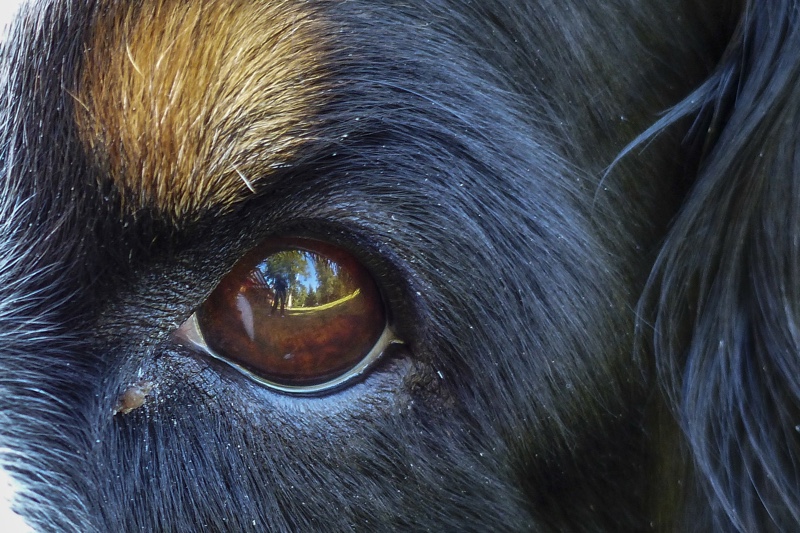The Skinny on Weight Loss in Cats
Find out how to identify weight loss in cats, along with treatment options and healthy weight tips
Pink eye, also known as conjunctivitis, is an infection or inflammation of the conjunctiva, the outermost layer of the eyeball and inside of the eyelids. It is also the most common type of dog eye infection . Dogs usually experience this condition in one eye but may contract it in both.
Canine conjunctivitis can be caused by many things. One of them is a virus. Like humans, dogs that are experiencing a cold or upper respiratory infection may have drainage from the eyes.
Many veterinary ophthalmologists do not feel that viral conjunctivitis contagious, but is, instead, species-specific.
Another cause of pink eye in dogs is bacteria. The bacteria Streptococcus and Staphylococcus are known culprits. While proven bacterial conjunctivitis in dogs is rare, it is highly contagious.
And, if you’re asking yourself, “can dogs get pink eye from humans?” The answer is yes! Therefore, if any one of your human family members has pink eye, you’ll want to take precautions to prevent the rest of the household from contracting it. This includes sterilization of shared spaces within the home, lots of hand washing, and avoiding contact with the eyes.
If any one of your human or furry family members has pink eye, you’ll want to take precautions to prevent the rest of the household from contracting it
Canine conjunctivitis may also be caused by airborne allergens, like dust, pollen, mold, dander, perfume or cosmetics, and smoke.
There is a possibility, too, for pink eye to be caused by an irritation or injury. Whether your dog is rolling around on the carpet or in the yard, their eyes can get rubbed and scratched. Plus, being on the ground makes it easy for dirt, dust, and other particles to get in their eyes.
Dog diseases like keratoconjunctivitis sicca (KCS), or dry eye, can also cause conjunctivitis, and may require chronic treatment. Dry eye can result from any condition that impairs your pet’s ability to produce tears.
So, how can you tell if your canine companion has pink eye? Just look into those puppy dog eyes! If you see any of the following signs, your dog likely has an infection and should be taken to the veterinarian for an examination.
Clinical signs of dog pink eye include:

If your dog develops conjunctivitis, a visit to your veterinarian will be necessary to diagnose the condition, and determine an appropriate treatment plan. The best treatment for pink eye, as determined by your veterinarian, will depend on its cause.
If your dog has bacterial conjunctivitis, your vet will most likely prescribe antibiotic eye drops or ointment. Administering eye drops or eye ointment can be tough, especially if your dog is squirmy. If possible, have someone assist you with the procedure.
Here’s how to give your dog eye drops or ointment:
For viral conjunctivitis, which results from the common cold and upper respiratory infection, your veterinarian may prescribe steroid eye drops or artificial tears to help wash out the goop. The prescription, along with the gentle wiping away any discharge or crust, will make your dog more comfortable while they’re getting over their illness.
Use a clean towel soaked in lukewarm water when wiping away build-up. Never scratch at the infected area with your finger or other hard objects, as permanent damage may result. Holding a cold compress on your pup’s eye can help soothe it as well.
If you would like to try treating your dog with a vitamin supplement, or make changes to your dog’s diet, discuss your options with your veterinarian. For tips on how to give your dog a vitamin or pill.

For a case of allergen-induced pink eye, vets might prescribe an antihistamine, nonsteroidal anti-inflammatory drugs, steroid eye drops, or artificial tears. Cleaning the affected area or applying a cold compress is good for relieving the irritation of allergens too.
If your dog’s eye infection was caused by an injury, debris, or friction during play, try to soothe the area and keep a watch on your pup until the eye heals.
Injuries to the eye sometimes include damage to the cornea. Your veterinarian may need to examine your dog’s eyes to be sure that corneal injury did not occur. If a corneal injury is present, your veterinarian can prescribe appropriate medication, severe cases may even require surgery. Medications used for other forms of conjunctivitis, like steroids, can make corneal injuries worse, sometimes leading to blindness. That is why it is so important to consult your vet.
You want to make sure your dog isn’t pawing, scratching, rubbing their face on the carpet, or doing anything that can damage the eye or surrounding skin. Pink eye, in all forms, is a bothersome condition, and your dog may have a hard time leaving their eye alone. If you notice any damaging behaviors, you might want to ask your vet for a cone.
There are a number of different home remedies on the internet. Some are helpful, and others can cause further harm. Your veterinarian can tell you which ones are safe to use.

Every pet parents goal is to keep their pal happy and healthy. These tips may help prevent your dog from contracting an eye infection:
Bacterial conjunctivitis can be tough to prevent, since we can’t see the bacteria lurking around our environment. But, keeping your pet’s sleep and play areas sterile can kill the bacteria and thwart further spreading.
Virus-caused pink eye, like bacterial conjunctivitis, can be pretty tricky to prevent. Sometimes, despite our best efforts to keep our family and selves healthy, we still get sick. However, it never hurts to try giving your dog’s immune system a boost with a vitamin-packed diet and lots of exercise. Here’s a look at more fruits and veggies your canine can have to get their vitamins.
If your dog has allergies, keeping your home free of dust, dander, and mold can help prevent a reaction. Be sure not to allow smoke or perfumes near an allergic dog either. Your vet can prescribe medications to stop flare-ups in their tracks as well.
Though we can’t always keep debris and irritants from getting in our pets’ eyes when they play, making sure the fur around their eyes is well-groomed can help. This will prevent little hairs from poking the inside of their eyes. It will also make it more difficult for dust, dirt, and other aggravating particles to get tangled or matted in the fur and fall into the eyes.
The American Society for the Prevention of Cruelty to Animals® (ASPCA®) provides a variety of dog grooming tips that you may find useful. Also, the treatment of common eye infections, like pink eye, can be covered by a pet health insurance plan. Get your free quote today!
(opens new window)